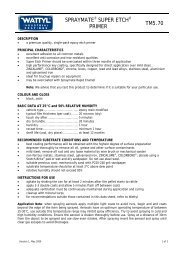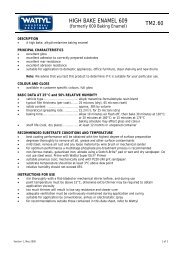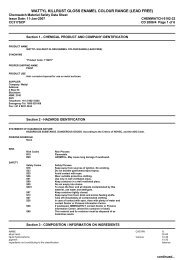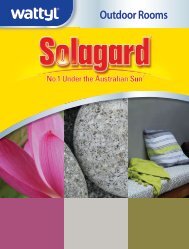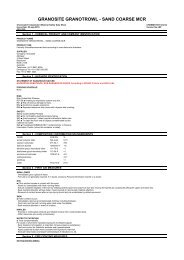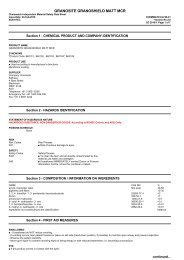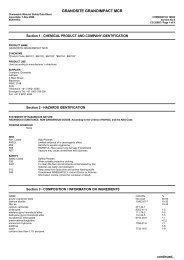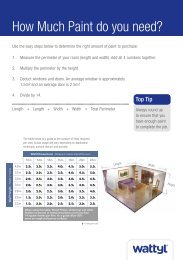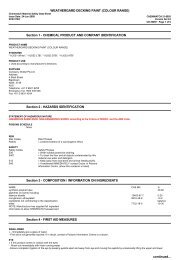MSDS - Wattyl
MSDS - Wattyl
MSDS - Wattyl
Create successful ePaper yourself
Turn your PDF publications into a flip-book with our unique Google optimized e-Paper software.
GRANOSITE GRANOSPRAY - ON FINE MCR<br />
Chemwatch Independent Material Safety Data Sheet<br />
Issue Date: 20-Sep-2010<br />
C9317EC<br />
CHEMWATCH Interim<br />
Version No:JRF<br />
Section 1 - CHEMICAL PRODUCT AND COMPANY IDENTIFICATION<br />
PRODUCT NAME<br />
GRANOSITE GRANOSPRAY - ON FINE MCR<br />
PRODUCT USE<br />
Formally GranoClassic ■ Used according to manufacturer's directions.<br />
SUPPLIER<br />
Company: Granosite<br />
Address:<br />
4 Steel Street<br />
Blacktown<br />
NSW, 2148<br />
Australia<br />
Telephone: +61 2 9621 6255<br />
Emergency Tel: +61 1800 039 008<br />
Fax: +61 2 9831 4244<br />
Section 2 - HAZARDS IDENTIFICATION<br />
STATEMENT OF HAZARDOUS NATURE<br />
HAZARDOUS SUBSTANCE. NON-DANGEROUS GOODS. According to NOHSC Criteria, and ADG Code.<br />
POISONS SCHEDULE<br />
None<br />
RISK<br />
Risk Codes Risk Phrases<br />
R37/38 ■ Irritating to respiratory system and skin.<br />
R41 ■ Risk of serious damage to eyes.<br />
SAFETY<br />
Safety Codes Safety Phrases<br />
S23 ■ Do not breathe gas/fumes/vapour/spray.<br />
S51 ■ Use only in well ventilated areas.<br />
S09 ■ Keep container in a well ventilated place.<br />
S53 ■ Avoid exposure - obtain special instructions before use.<br />
S40 ■ To clean the floor and all objects contaminated by this<br />
material use water.<br />
S07 ■ Keep container tightly closed.<br />
S46 ■ If swallowed IMMEDIATELY contact Doctor or Poisons<br />
Information Centre. (show this container or label).<br />
Section 3 - COMPOSITION / INFORMATION ON INGREDIENTS<br />
NAME CAS RN %<br />
acrylic copolymer latex Not avail. 5-15<br />
residual monomer<br />
trace<br />
calcium carbonate 471-34-1 10-30<br />
silica crystalline - quartz 14808-60-7 30-60<br />
titanium dioxide 13463-67-7 1-2<br />
ethylene glycol monobutyl ether 111-76-2 1-2<br />
ammonium hydroxide 1336-21-6
· Evaluate renal status and begin haemodialysis if indicated. [I.L.O].<br />
Section 5 - FIRE FIGHTING MEASURES<br />
EXTINGUISHING MEDIA<br />
· There is no restriction on the type of extinguisher which may be used.<br />
· Use extinguishing media suitable for surrounding area.<br />
FIRE FIGHTING<br />
· Alert Fire Brigade and tell them location and nature of hazard.<br />
· Wear breathing apparatus plus protective gloves for fire only.<br />
· Prevent, by any means available, spillage from entering drains or water courses.<br />
· Use fire fighting procedures suitable for surrounding area.<br />
FIRE/EXPLOSION HAZARD<br />
· Non combustible.<br />
· Not considered a significant fire risk, however containers may burn., carbon dioxide (CO2), nitrogen oxides (NOx), silicon dioxide (SiO2), other pyrolysis products<br />
typical of burning organic material.<br />
May emit poisonous fumes.<br />
FIRE INCOMPATIBILITY<br />
· Avoid contamination with oxidising agents i.e. nitrates, oxidising acids, chlorine bleaches, pool chlorine etc. as ignition may result.<br />
HAZCHEM<br />
None<br />
PERSONAL PROTECTION<br />
Glasses: Gloves: Respirator:<br />
Chemical goggles. PVC chemical resistant type. Type KAX-P Filter of sufficient capacity<br />
Section 6 - ACCIDENTAL RELEASE MEASURES<br />
MINOR SPILLS<br />
· Clean up all spills immediately.<br />
· Avoid breathing vapours and contact with skin and eyes.<br />
· Control personal contact by using protective equipment.<br />
· Contain and absorb spill with sand, earth, inert material or vermiculite.<br />
MAJOR SPILLS<br />
■ Moderate hazard.<br />
· Clear area of personnel and move upwind.<br />
· Alert Fire Brigade and tell them location and nature of hazard.<br />
· Wear breathing apparatus plus protective gloves.<br />
· Prevent, by any means available, spillage from entering drains or water course.<br />
Personal Protective Equipment advice is contained in Section 8 of the <strong>MSDS</strong>.<br />
Section 7 - HANDLING AND STORAGE<br />
PROCEDURE FOR HANDLING<br />
· Avoid all personal contact, including inhalation.<br />
· Wear protective clothing when risk of exposure occurs.<br />
· Use in a well-ventilated area.<br />
· Avoid contact with moisture.<br />
SUITABLE CONTAINER<br />
· Polyethylene or polypropylene container.<br />
· Packing as recommended by manufacturer.<br />
· Check all containers are clearly labelled and free from leaks.<br />
STORAGE INCOMPATIBILITY<br />
· Avoid reaction with oxidising agents.<br />
STORAGE REQUIREMENTS<br />
· Store in original containers.<br />
· Keep containers securely sealed.<br />
· Store in a cool, dry, well-ventilated area.<br />
· Store away from incompatible materials and foodstuff containers.<br />
Section 8 - EXPOSURE CONTROLS / PERSONAL PROTECTION<br />
EXPOSURE CONTROLS<br />
Source Material TWA ppm TWA mg/m³ STEL ppm STEL mg/m³ Notes<br />
___________ ___________ _______ _______ _______ _______ _______<br />
Australia Exposure calcium carbonate<br />
10 (see Chapter 14)<br />
Standards<br />
(Calcium carbonate<br />
Australia Exposure<br />
Standards<br />
Australia Exposure<br />
Standards<br />
Australia Exposure<br />
Standards<br />
Australia Exposure<br />
Standards<br />
(a))<br />
silica crystalline -<br />
quartz (Silica -<br />
Crystalline Quartz)<br />
silica crystalline -<br />
quartz (Silica -<br />
Amorphous Fumed<br />
silica (respirable<br />
dust))<br />
titanium dioxide<br />
(Titanium dioxide<br />
(a))<br />
ethylene glycol<br />
monobutyl ether (2-<br />
Butoxyethanol)<br />
Australia Exposure ammonium<br />
Standards<br />
hydroxide<br />
(Ammonia)<br />
The following materials had no OELs on our records<br />
• water: CAS:7732-18-5<br />
0.1 (see Chapter 14)<br />
2 (see Chapter 14)<br />
10 (see Chapter 14)<br />
20 96.9 50 242 Sk<br />
25 17 35 24<br />
PERSONAL PROTECTION
RESPIRATOR<br />
Type KAX- P Filter of sufficient capacity<br />
EYE<br />
· Safety glasses with side shields.<br />
· Chemical goggles.<br />
· Contact lenses may pose a special hazard; soft contact lenses may absorb and concentrate irritants. A written policy document, describing the wearing of lens or<br />
restrictions on use, should be created for each workplace or task. This should include a review of lens absorption and adsorption for the class of chemicals in use<br />
and an account of injury experience. Medical and first- aid personnel should be trained in their removal and suitable equipment should be readily available. In the<br />
event of chemical exposure, begin eye irrigation immediately and remove contact lens as soon as practicable. Lens should be removed at the first signs of eye redness<br />
or irritation - lens should be removed in a clean environment only after workers have washed hands thoroughly. [CDC NIOSH Current Intelligence Bulletin 59].<br />
HANDS/FEET<br />
■ Suitability and durability of glove type is dependent on usage. Important factors in the selection of gloves include: such as:<br />
· frequency and duration of contact,<br />
· chemical resistance of glove material,<br />
· glove thickness and<br />
· dexterity.<br />
· Wear chemical protective gloves, eg. PVC.<br />
· Wear safety footwear or safety gumboots, eg. Rubber.<br />
OTHER<br />
· Overalls.<br />
· P.V.C. apron.<br />
· Barrier cream.<br />
· Skin cleansing cream.<br />
ENGINEERING CONTROLS<br />
■ General exhaust is adequate under normal operating conditions. Local exhaust ventilation may be required in specific circumstances.<br />
Section 9 - PHYSICAL AND CHEMICAL PROPERTIES<br />
APPEARANCE<br />
■ Acrylic polymer emulsions may contain residual traces of odourous acrylic monomers; the amounts remaining in compounded mixtures represents a very low order of<br />
exposure, however this may become noticeable with some materials particularly in confined or poorly ventilated spaces.<br />
White or coloured acrylic texture coating with a mild ammoniacal odour;<br />
mixes with water.<br />
PHYSICAL PROPERTIES<br />
Liquid.<br />
Mixes with water.<br />
State<br />
Melting<br />
Range<br />
(ºC)<br />
Boiling<br />
Range<br />
(ºC)<br />
Flash<br />
Point<br />
(ºC)<br />
Decomposition<br />
Temp<br />
(ºC)<br />
Autoignition<br />
Temp<br />
(ºC)<br />
Upper<br />
Explosive<br />
Limit<br />
(%)<br />
Lower<br />
Explosive<br />
Limit<br />
(%)<br />
Volatile<br />
Component<br />
(%<br />
vol)<br />
Liquid<br />
Not<br />
available.<br />
100<br />
Not<br />
applicable<br />
Not<br />
available.<br />
Not<br />
applicable<br />
Not<br />
applicable<br />
Not<br />
applicable<br />
15-<br />
25<br />
Molecular<br />
Weight<br />
Viscosity<br />
Solubility<br />
in<br />
water<br />
(g/L)<br />
pH<br />
(1%<br />
solution)<br />
pH<br />
(as<br />
supplied)<br />
Vapour<br />
Pressure<br />
(kPa)<br />
Specific<br />
Gravity<br />
(water=1)<br />
Relative<br />
Vapour<br />
Density<br />
(air=1)<br />
Evaporation<br />
Rate<br />
Not<br />
applicable.<br />
Not<br />
Available<br />
Miscible<br />
Not<br />
available<br />
10<br />
Not<br />
available.<br />
1.79<br />
-<br />
1.87<br />
>1<br />
Not<br />
available<br />
ethylene glycol monobutyl ether<br />
■ log Kow (Prager 1995): 0.83<br />
■ log Kow (Sangster 1997): 0.8<br />
Section 10 - CHEMICAL STABILITY AND REACTIVITY INFORMATION<br />
CONDITIONS CONTRIBUTING TO INSTABILITY<br />
· Presence of incompatible materials.<br />
· Product is considered stable.<br />
· Hazardous polymerisation will not occur.<br />
For incompatible materials - refer to Section 7 - Handling and Storage.<br />
Section 11 - TOXICOLOGICAL INFORMATION<br />
POTENTIAL HEALTH EFFECTS<br />
ACUTE HEALTH EFFECTS<br />
■ Risk of serious damage to eyes.<br />
■ Irritating to respiratory system and skin.<br />
CHRONIC HEALTH EFFECTS<br />
■ Not applicable.<br />
TOXICITY AND IRRITATION<br />
WATER:<br />
ACRYLIC COPOLYMER LATEX:<br />
■ No significant acute toxicological data identified in literature search.<br />
ETHYLENE GLYCOL MONOBUTYL ETHER:<br />
AMMONIUM HYDROXIDE:<br />
CALCIUM CARBONATE:<br />
■ The material may produce severe irritation to the eye causing pronounced inflammation. Repeated or prolonged exposure to irritants may produce conjunctivitis.
AMMONIUM HYDROXIDE:<br />
CALCIUM CARBONATE:<br />
■ Asthma- like symptoms may continue for months or even years after exposure to the material ceases. This may be due to a non- allergenic condition known as reactive<br />
airways dysfunction syndrome (RADS) which can occur following exposure to high levels of highly irritating compound.<br />
SILICA CRYSTALLINE - QUARTZ:<br />
TITANIUM DIOXIDE:<br />
ETHYLENE GLYCOL MONOBUTYL ETHER:<br />
AMMONIUM HYDROXIDE:<br />
CALCIUM CARBONATE:<br />
■ unless otherwise specified data extracted from RTECS - Register of Toxic Effects of Chemical Substances.<br />
ETHYLENE GLYCOL MONOBUTYL ETHER:<br />
TITANIUM DIOXIDE:<br />
■ The material may cause skin irritation after prolonged or repeated exposure and may produce a contact dermatitis (nonallergic). This form of dermatitis is often<br />
characterised by skin redness (erythema) and swelling epidermis.<br />
■ unless otherwise specified data extracted from RTECS - Register of Toxic Effects of Chemical Substances.<br />
■ The material may produce severe irritation to the eye causing pronounced inflammation. Repeated or prolonged exposure to irritants may produce conjunctivitis.<br />
CALCIUM CARBONATE:<br />
TOXICITY<br />
IRRITATION<br />
Oral (Rat) LD50: 6450 mg/kg<br />
Skin (rabbit): 500 mg/24h-Moderate<br />
Eye (rabbit): 0.75 mg/24h - SEVERE<br />
■ The material may cause skin irritation after prolonged or repeated exposure and may produce a contact dermatitis (nonallergic). This form of dermatitis is often<br />
characterised by skin redness (erythema) and swelling the epidermis.<br />
No evidence of carcinogenic properties. No evidence of mutagenic or<br />
teratogenic effects.<br />
SILICA CRYSTALLINE - QUARTZ:<br />
TOXICITY<br />
IRRITATION<br />
Inhalation (human) LCLo: 0.3 mg/m³/10Y<br />
Nil Reported<br />
Inhalation (human) TCLo: 16 mppcf*/8H/17.9Y<br />
Inhalation (rat) TCLo: 50 mg/m³/6H/71W<br />
■ WARNING: For inhalation exposure ONLY: This substance has been classified by the IARC as Group 1: CARCINOGENIC TO HUMANS.<br />
Intermittent; focal fibrosis, (pneumoconiosis), cough, dyspnoea<br />
Intermittent; liver - tumours.<br />
* Millions of particles per cubic foot (based on impinger samples counted by light field techniques).<br />
NOTE : the physical nature of quartz in the product determines whether it is likely to present a chronic health problem. To be a hazard the material must enter the<br />
breathing zone as respirable particles.<br />
TITANIUM DIOXIDE:<br />
TOXICITY<br />
IRRITATION<br />
Oral (Rat) LD50: >20000 mg/kg * Skin (human): 0.3 mg /3D (int)-Mild *<br />
Oral (Mouse) LD50: >10000 mg/kg *<br />
■ The material may produce moderate eye irritation leading to inflammation. Repeated or prolonged exposure to irritants may produce conjunctivitis.<br />
For titanium dioxide:<br />
Humans can be exposed to titanium dioxide via inhalation, ingestion or dermal contact. In human lungs, the clearance kinetics of titanium dioxide is poorly<br />
characterized relative to that in experimental animals.<br />
* IUCLID<br />
ETHYLENE GLYCOL MONOBUTYL ETHER:<br />
TOXICITY<br />
IRRITATION<br />
Oral (rat) LD50: 470 mg/kg<br />
Skin (rabbit): 500 mg, open; Mild<br />
Dermal (rabbit) LD50: 220 mg/kg<br />
Eye (rabbit): 100 mg/24h-Moderate<br />
Inhalation (human) TCLo: 100 ppm<br />
Eye (rabbit): 100 mg SEVERE<br />
Inhalation (human) TCLo: 195 ppm/8h * [Union Carbide]<br />
Inhalation (Rat) LC50: 450 ppm *<br />
■ For ethylene glycol:<br />
Ethylene glycol is quickly and extensively absorbed through the gastrointestinal tract. Limited information suggests that it is also absorbed through the respiratory<br />
tract; dermal absorption is apparently slow.<br />
For ethylene glycol monoalkyl ethers and their acetates (EGMAEs):<br />
Typical members of this category are ethylene glycol propylene ether (EGPE), ethylene glycol butyl ether (EGBE) and ethylene glycol hexyl ether (EGHE) and their<br />
acetates.<br />
EGMAEs are substrates for alcohol dehydrogenase isozyme ADH- 3, which catalyzes the conversion of their terminal alcohols to aldehydes (which are transient<br />
metabolites).<br />
Acute Toxicity: Oral LD50 values in rats for all category members range from 739 (EGHE) to 3089 mg/kg bw (EGPE), with values increasing with decreasing molecular<br />
weight.<br />
Exposure of pregnant rats to ethylene glycol monobutyl ether (2- butoxyethanol) at 100 ppm or rabbits at 200 ppm during organogenesis resulted in maternal toxicity<br />
and embryotoxicity including a decreased number of viable implantations per litter. Slight foetoxicity in the form of poorly ossified or unossified skeletal elements<br />
was also apparent in rats.<br />
At least one researcher has stated that the reproductive effects were less than that of other monoalkyl ethers of ethylene glycol.<br />
NOTE: Changes in kidney, liver, spleen and lungs are observed in animals exposed to high concentrations of this substance by all routes.<br />
AMMONIUM HYDROXIDE:<br />
TOXICITY<br />
IRRITATION<br />
Oral (rat) LD50: 350 mg/kg<br />
Eye (rabbit): 0.25 mg SEVERE<br />
Oral (human) LDLo: 43 mg/kg<br />
Eye (rabbit): 1 mg/30s SEVERE<br />
Inhalation (human) LCLo: 5000 ppm/5m<br />
Inhalation (human) TCLo: 20 ppm<br />
Inhalation (rat) LC50: 2000 ppm/4h<br />
Unreported (man) LDLo: 132 mg/kg<br />
CARCINOGEN<br />
Silica,<br />
crystalline<br />
(inhaled<br />
in<br />
the<br />
form<br />
of<br />
quartz<br />
or<br />
cristobalite<br />
from<br />
occupational<br />
sources)<br />
Silica,<br />
amorphous<br />
International<br />
Agency<br />
for<br />
Research<br />
on<br />
Cancer<br />
(IARC)<br />
-<br />
Agents<br />
Reviewed<br />
by the<br />
IARC<br />
Monographs<br />
International<br />
Agency<br />
for<br />
Research<br />
on<br />
Cancer<br />
(IARC)<br />
-<br />
Agents<br />
Reviewed<br />
Group 1<br />
Group 3
Titanium<br />
dioxide<br />
2-<br />
Butoxyethanol<br />
by the<br />
IARC<br />
Monographs<br />
International<br />
Agency<br />
for<br />
Research<br />
on<br />
Cancer<br />
(IARC)<br />
-<br />
Agents<br />
Reviewed<br />
by the<br />
IARC<br />
Monographs<br />
International<br />
Agency<br />
for<br />
Research<br />
on<br />
Cancer<br />
(IARC)<br />
-<br />
Agents<br />
Reviewed<br />
by the<br />
IARC<br />
Monographs<br />
Group<br />
Group 3<br />
2B<br />
SKIN<br />
ethylene<br />
glycol<br />
monobutyl<br />
ether<br />
ND Notes Sk<br />
Section 12 - ECOLOGICAL INFORMATION<br />
No data<br />
Ecotoxicity<br />
Ingredient<br />
Persistence:<br />
Persistence:<br />
Water/Soil<br />
Air<br />
Bioaccumulation<br />
Mobility<br />
silica<br />
crystalline<br />
-<br />
LOW LOW HIGH<br />
quartz<br />
titanium<br />
dioxide<br />
HIGH LOW HIGH<br />
ethylene<br />
glycol<br />
monobutyl<br />
LOW LOW LOW HIGH<br />
ether<br />
ammonium<br />
hydroxide<br />
LOW LOW HIGH<br />
water LOW LOW HIGH<br />
Section 13 - DISPOSAL CONSIDERATIONS<br />
· DO NOT allow wash water from cleaning or process equipment to enter drains.<br />
· It may be necessary to collect all wash water for treatment before disposal.<br />
· In all cases disposal to sewer may be subject to local laws and regulations and these should be considered first.<br />
· Where in doubt contact the responsible authority.<br />
· Recycle wherever possible.<br />
· Consult manufacturer for recycling options or consult local or regional waste management authority for disposal if no suitable treatment or disposal facility can be<br />
identified.<br />
· Dispose of by: burial in a land-fill specifically licenced to accept chemical and / or pharmaceutical wastes or incineration in a licenced apparatus (after admixture with<br />
suitable combustible material).<br />
· Decontaminate empty containers. Observe all label safeguards until containers are cleaned and destroyed.<br />
Section 14 - TRANSPORTATION INFORMATION<br />
HAZCHEM:<br />
None (ADG7)<br />
NOT REGULATED FOR TRANSPORT OF DANGEROUS GOODS: ADG7, UN, IATA, IMDG<br />
Section 15 - REGULATORY INFORMATION<br />
POISONS SCHEDULE<br />
None<br />
REGULATIONS<br />
Regulations for ingredients<br />
calcium carbonate (CAS: 471-34-1,13397-26-7,15634-14-7,1317-65-3) is found on the following regulatory lists;<br />
"Australia High Volume Industrial Chemical List (HVICL)","Australia Inventory of Chemical Substances (AICS)","Australia Therapeutic Goods Administration (TGA)<br />
Substances that may be used as active ingredients in Listed medicines","CODEX General Standard for Food Additives (GSFA) - Additives Permitted for Use in Food in<br />
General, Unless Otherwise Specified, in Accordance with GMP","GESAMP/EHS Composite List - GESAMP Hazard Profiles","IMO IBC Code Chapter 17: Summary of<br />
minimum requirements","International Council of Chemical Associations (ICCA) - High Production Volume List","OECD Representative List of High Production Volume<br />
(HPV) Chemicals"<br />
silica crystalline - quartz (CAS: 14808-60-7,122304-48-7,122304-49-8,12425-26-2,1317-79-9,70594-95-5,87347-84-0) is found on the following regulatory lists;<br />
"Australia - New South Wales Hazardous Substances Prohibited for Specific Uses","Australia - New South Wales Hazardous Substances Requiring Health<br />
Surveillance","Australia - South Australia Hazardous Substances Requiring Health Surveillance","Australia - Tasmania Hazardous Substances Prohibited for Specified<br />
Uses","Australia - Tasmania Hazardous Substances Requiring Health Surveillance","Australia - Western Australia Hazardous Substances Requiring Health<br />
Surveillance","Australia Exposure Standards","Australia Hazardous Substances","Australia Hazardous Substances Requiring Health Surveillance","Australia High<br />
Volume Industrial Chemical List (HVICL)","Australia Inventory of Chemical Substances (AICS)","Australia Occupational Health and Safety (Commonwealth Employment)<br />
(National Standards) Regulations 1994 - Hazardous Substances Requiring Health Surveillance","International Agency for Research on Cancer (IARC) - Agents<br />
Reviewed by the IARC Monographs","OECD Representative List of High Production Volume (HPV) Chemicals"<br />
titanium dioxide (CAS: 13463-67-7,1317-70-0,1317-80-2,12188-41-9,1309-63-3,100292-32-8,101239-53-6,116788-85-3,12000-59-8,12701-76-7,12767-65-6,12789-
63-8,1344-29-2,185323-71-1,185828-91-5,188357-76-8,188357-79-1,195740-11-5,221548-98-7,224963-00-2,246178-32-5,252962-41-7,37230-92-5,37230-94-7,37230-<br />
95-8,37230-96-9,39320-58-6,39360-64-0,39379-02-7,416845-43-7,494848-07-6,494848-23-6,494851-77-3,494851-98-8,55068-84-3,55068-85-4,552316-51-5,62338-<br />
64-1,767341-00-4,97929-50-5,98084-96-9) is found on the following regulatory lists;<br />
"Australia Exposure Standards","Australia High Volume Industrial Chemical List (HVICL)","Australia Inventory of Chemical Substances (AICS)","Australia Therapeutic<br />
Goods Administration (TGA) Substances that may be used as active ingredients in Listed medicines","Australia Therapeutic Goods Administration (TGA) Sunscreening<br />
agents permitted as active ingredients in listed products","CODEX General Standard for Food Additives (GSFA) - Additives Permitted for Use in Food in General, Unless<br />
Otherwise Specified, in Accordance with GMP","GESAMP/EHS Composite List - GESAMP Hazard Profiles","IMO IBC Code Chapter 17: Summary of minimum<br />
requirements","International Agency for Research on Cancer (IARC) - Agents Reviewed by the IARC Monographs","OECD Representative List of High Production<br />
Volume (HPV) Chemicals"<br />
ethylene glycol monobutyl ether (CAS: 111-76-2) is found on the following regulatory lists;<br />
"Australia Exposure Standards","Australia Hazardous Substances","Australia High Volume Industrial Chemical List (HVICL)","Australia Inventory of Chemical Substances<br />
(AICS)","IMO MARPOL 73/78 (Annex II) - List of Other Liquid Substances","International Agency for Research on Cancer (IARC) - Agents Reviewed by the IARC<br />
Monographs","OECD Representative List of High Production Volume (HPV) Chemicals"<br />
ammonium hydroxide (CAS: 1336-21-6) is found on the following regulatory lists;<br />
"Australia Hazardous Substances","Australia Inventory of Chemical Substances (AICS)","Australia Standard for the Uniform Scheduling of Drugs and Poisons (SUSDP) -<br />
Appendix F (Part 3)","CODEX General Standard for Food Additives (GSFA) - Additives Permitted for Use in Food in General, Unless Otherwise Specified, in Accordance<br />
with GMP","IMO MARPOL 73/78 (Annex II) - List of Noxious Liquid Substances Carried in Bulk","International Council of Chemical Associations (ICCA) - High Production<br />
Volume List","OECD Representative List of High Production Volume (HPV) Chemicals"<br />
water (CAS: 7732-18-5) is found on the following regulatory lists;<br />
"Australia Inventory of Chemical Substances (AICS)","IMO IBC Code Chapter 18: List of products to which the Code does not apply","OECD Representative List of High<br />
Production Volume (HPV) Chemicals"<br />
No data for Granosite GRANOSPRAY - ON FINE MCR (CW: 8064-05)<br />
No data for acrylic copolymer latex (CAS: , Not avail)<br />
Section 16 - OTHER INFORMATION<br />
INGREDIENTS WITH MULTIPLE CAS NUMBERS<br />
Ingredient<br />
CAS<br />
Name<br />
calcium<br />
471-34-1, 13397-26-7, 15634-14-7, 1317-65-3<br />
carbonate<br />
silica<br />
crystalline -<br />
quartz<br />
titanium<br />
dioxide<br />
■ Classification of the preparation and its individual components has drawn on official and authoritative sources as well as independent review by the Chemwatch<br />
Classification committee using available literature references.<br />
A list of reference resources used to assist the committee may be found at:<br />
www.chemwatch.net/references.<br />
■ The (M)SDS is a Hazard Communication tool and should be used to assist in the Risk Assessment. Many factors determine whether the reported Hazards are Risks in<br />
the workplace or other settings.<br />
This document is copyright. Apart from any fair dealing for the purposes of private study, research, review or<br />
criticism, as permitted under the Copyright Act, no part may be reproduced by any process without written<br />
permission from CHEMWATCH. TEL (+61 3) 9572 4700.<br />
Issue Date: 20-Sep-2010<br />
Print Date: 20-Sep-2010<br />
14808-60-7, 122304-48-7, 122304-49-8, 12425-26-2, 1317-79-9, 70594-95-5, 87347-84-0<br />
13463-67-7, 1317-70-0, 1317-80-2, 12188-41-9, 1309-63-3, 100292-32-8, 101239-53-6, 116788-85-3, 12000-59-8, 12701-76-7, 12767-65-6, 12789-<br />
63-8, 1344-29-2, 185323-71-1, 185828-91-5, 188357-76-8, 188357-79-1, 195740-11-5, 221548-98-7, 224963-00-2, 246178-32-5, 252962-41-7,<br />
37230-92-5, 37230-94-7, 37230-95-8, 37230-96-9, 39320-58-6, 39360-64-0, 39379-02-7, 416845-43-7, 494848-07-6, 494848-23-6, 494851-77-3,<br />
494851-98-8, 55068-84-3, 55068-85-4, 552316-51-5, 62338-64-1, 767341-00-4, 97929-50-5, 98084-96-9<br />
This is the end of the <strong>MSDS</strong>.




